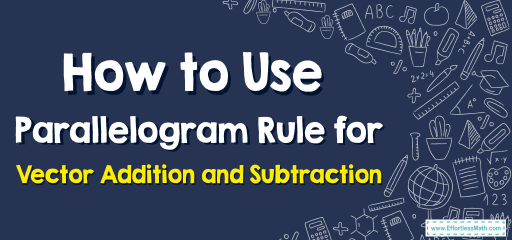How to Use Parallelogram Rule for Vector Addition and Subtraction
Let's delve into the world of vector operations, specifically focusing on the renowned Parallelogram Rule, a cornerstone in the realm of vector algebra. This guide will be a journey that marries theoretical understanding with vivid geometrical representation.

Step-by-step Guide to Understand Parallelogram Rule for Vector Addition and Subtraction
Here is a step-by-step guide to understanding the parallelogram rule for vector addition and subtraction:
Preliminary Notions
- Vectors Defined: Vectors are mathematical entities endowed with both magnitude and direction. They differ from scalar quantities, which possess only magnitude.
- Parallelogram Visualization: Imagine a parallelogram as a four-sided figure with opposite sides that are equal in length and parallel.
Chapter I: The Parallelogram Rule for Vector Addition
- Laying the Groundwork: Given two vectors, \(a\) and \(b\), originating from the same initial point, represent them as two adjacent sides of a parallelogram.
- Construction: Draw the vectors such that their tails coincide. The parallelogram is then constructed using these vectors as consecutive sides.
- Resultant Vector: The diagonal of the parallelogram that starts from the common tail of the two vectors is the sum (or resultant) of the vectors. Mathematically represented as \(a+b\), this resultant vector completes the parallelogram.
- Nuances to Remember: The length (magnitude) of the diagonal represents the magnitude of the resultant vector. Its direction, as indicated by the arrow, showcases the combined effect of vectors \(a\) and \(b\).
Chapter II: The Parallelogram Rule for Vector Subtraction
- Inception: Vector subtraction can be visualized as the addition of a negative vector. The negative of a vector, \(−b\), is a vector of the same magnitude as \(b\) but in the opposite direction.
- Constructive Visualization: Start by drawing vector \(a\). Now, from the tail of \(a\), draw the negative of vector \(b\), denoted as \(−b\).
- Building the Parallelogram: With vectors \(a\) and \(−b\) as adjacent sides, construct the parallelogram.
- Deciphering the Difference: The diagonal starting from the common tail of \(a\) and \(−b\) represents the difference between the vectors, given by \(a−b\). Its magnitude and direction embody the essence of this vector subtraction.
Epilogue: A Reflective Pause
- The Parallelogram Rule offers a harmonious blend of algebra and geometry, making abstract vector operations palpable and visually graspable.
- As with all mathematical rules, understanding the Parallelogram Rule’s underpinnings and consistently practicing its applications will transform it from a mere rule into an intuitive tool.
May this extensive guide serve as a beacon in your journey to mastering the Parallelogram Rule for vector addition and subtraction. Embrace the complexity, and let the vectors guide your way!
Related to This Article
More math articles
- How to Determine Indeterminate Form and Vague Limits
- How to Apply Limit Properties
- How to Use Benchmark to Compare Fractions?
- ATI TEAS 7 Math Worksheets: FREE & Printable
- 3rd Grade SOL Math Worksheets: FREE & Printable
- FREE 6th Grade SBAC Math Practice Test
- 6th Grade WVGSA Math Worksheets: FREE & Printable
- What Kind of Math Learner Is Your Child?
- ALEKS Math Formulas
- Top 10 STAAR Grade 8 Math Books: A Comprehenisve Review
























What people say about "How to Use Parallelogram Rule for Vector Addition and Subtraction - Effortless Math: We Help Students Learn to LOVE Mathematics"?
No one replied yet.